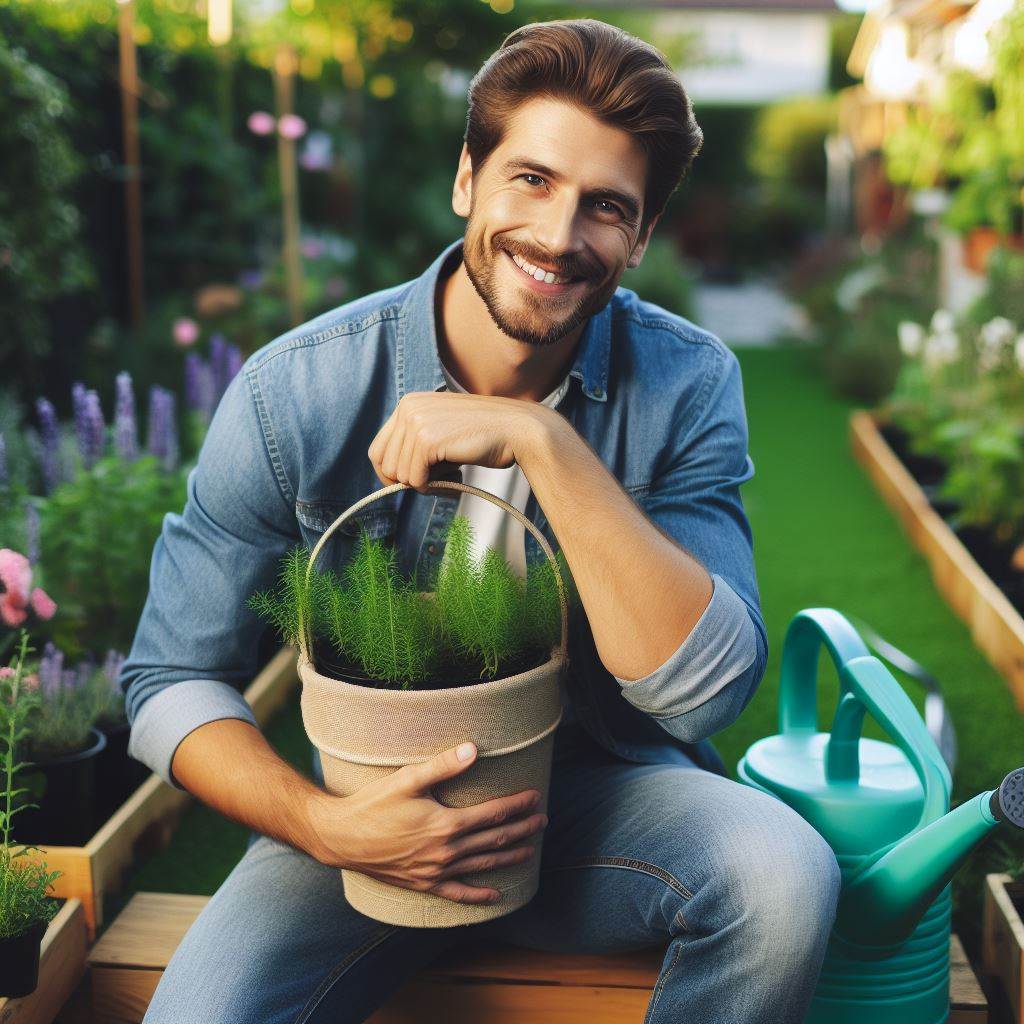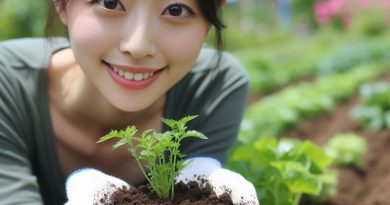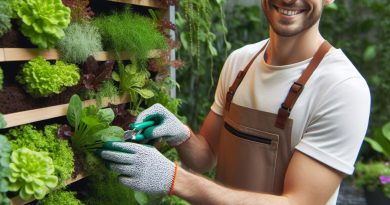Water-Saving Tactics in Organic Gardening
Last Updated on March 2, 2024
Introduction
Importance of water conservation in gardening
Water is a vital resource for all living organisms, and in gardening, water conservation takes on a crucial role.
Organic gardening, which prioritizes environmentally-friendly and sustainable practices, must incorporate water-saving tactics to ensure success.
By implementing effective strategies, gardeners can reduce water waste and preserve this valuable resource, contributing to a healthier planet.
Thesis statement: Water-saving tactics are crucial for successful organic gardening
Water-saving tactics can have a significant impact on organic gardens.
Efficient irrigation systems, such as drip irrigation or soaker hoses, minimize water loss through evaporation and runoff.
Mulching, another water-saving technique, helps retain moisture in the soil, reducing the need for frequent watering.
Capturing rainwater in barrels provides an additional water source and reduces reliance on municipal supplies.
Plant selection also plays a key role in water conservation.
Choosing drought-tolerant plants that are adapted to local climates can significantly decrease water requirements.
These plants have evolved to survive with minimal water, making them ideal for water-conscious gardeners.
Additionally, grouping plants with similar water needs and positioning them strategically can further optimize water usage.
Regular observation and monitoring are essential to identify water-related issues promptly.
Checking soil moisture levels helps avoid over or underwatering.
Adjusting watering schedules based on weather conditions and plant needs ensures water is used efficiently.
Essentially, water-saving tactics are fundamental for successful organic gardening.
By implementing strategies such as efficient irrigation systems, mulching, plant selection, and regular monitoring, gardeners can conserve water, reduce waste, and promote sustainable practices.
Water is a precious resource, and by protecting it, we contribute to a healthier environment for ourselves and future generations.
Understanding Water Conservation in Organic Gardening
Organic gardening principles
- Organic gardening focuses on the use of natural methods to grow plants without the use of synthetic chemicals.
- It involves building healthy soil, promoting biodiversity, and working with nature to create a sustainable ecosystem.
- Organic gardening avoids the use of chemical fertilizers, pesticides, and herbicides, which can contaminate water sources.
Clarification of the relationship between water conservation and organic gardening
- Water conservation is an essential aspect of organic gardening as it promotes responsible and sustainable use of water resources.
- Organic gardening practices can help conserve water by retaining moisture in the soil and reducing water evaporation.
- By using water-saving tactics, organic gardeners can minimize the need for irrigation and rely on natural rainfall.
Importance of using water-saving tactics in organic gardening
- Water is a precious resource, and using it wisely is crucial for the environment and future generations.
- Water-saving tactics in organic gardening not only help conserve water but also promote better plant health and growth.
- By conserving water, organic gardeners can reduce their ecological footprint and contribute to a more sustainable planet.
Effective water-saving tactics in organic gardening
Now, let’s delve deeper into the topic and explore some effective water-saving tactics in organic gardening:
- Mulching: Applying a layer of organic mulch around plants helps retain moisture in the soil, reducing the need for frequent watering.
- Proper watering techniques: Watering plants deeply and infrequently encourages deep root growth, making them more resilient to drought conditions.
- Drip irrigation: Using drip irrigation systems delivers water directly to the plant’s root zone, minimizing water loss through evaporation or runoff.
- Rainwater harvesting: Collecting rainwater in barrels or tanks provides a free and sustainable source of water for garden irrigation.
- Companion planting: Pairing plants with different water needs together can help create a microclimate that conserves water and promotes mutual growth.
- Plant selection: Opting for drought-tolerant or native plants that are naturally adapted to the local climate requires less water and maintenance.
- Soil improvement: Enhancing soil structure with organic matter, such as compost, helps improve water retention and drainage.
- Timing of watering: Watering plants during the cooler parts of the day, such as early morning or late evening, reduces evaporation loss.
- Water-efficient tools: Using watering cans or hose nozzles with adjustable flow settings allows for precise and efficient watering.
- Monitoring and adjusting: Regularly checking soil moisture levels and adjusting watering schedules accordingly helps avoid water waste.
By implementing these water-saving tactics, organic gardeners can minimize their water usage while still growing healthy and productive plants.
Not only will they save water, but they will also contribute to the conservation of this precious resource and promote a sustainable gardening practice.
In essence, understanding water conservation in organic gardening is essential for gardeners who wish to practice sustainable and environmentally-friendly cultivation methods.
By adopting water-saving tactics and following organic gardening principles, gardeners can contribute to the preservation of water resources while enjoying the benefits of a thriving and bountiful garden.
Read: Composting 101: Turn Waste into Garden Gold
Choosing Drought-Tolerant Plants
Definition and characteristics of drought-tolerant plants
Drought-tolerant plants are species that have evolved to survive in arid or dry conditions.
They possess unique characteristics that enable them to conserve water and thrive even when water availability is limited.
These plants are a smart choice for organic gardeners looking to reduce water usage and maintain a sustainable garden.
- Deep root systems: Drought-tolerant plants develop deep and extensive root systems that help them access water stored deep within the soil. This adaptation allows them to withstand extended periods of drought without suffering from water stress.
- Thick and waxy leaves: Many drought-tolerant plants have thick, waxy leaves that minimize water loss through transpiration. These leaves act as a natural barrier, reducing evaporation and conserving precious water.
- Succulent characteristics: Some drought-tolerant plants, such as cacti and succulents, store water in their leaves, stems, or roots. These water reservoirs enable these plants to survive in extremely dry environments by utilizing stored water during periods of drought.
Benefits of growing drought-tolerant plants in organic gardening
- Water conservation: One of the primary advantages of choosing drought-tolerant plants is their ability to reduce water consumption in organic gardening. These plants require less irrigation, saving both water resources and utility bills.
- Environmental sustainability: By growing drought-tolerant plants, organic gardeners contribute to the overall sustainability of their gardens and the environment. Conserving water helps protect natural water sources and reduces the need for energy-intensive irrigation practices.
- Low maintenance: Drought-tolerant plants often require minimal care once established. Their natural adaptations make them resilient and less susceptible to pests and diseases, leading to lower maintenance requirements and fewer chemical interventions.
Examples of popular drought-tolerant plants for organic gardens
- Lavender (Lavandula spp.): This fragrant herb features aromatic, silver-gray foliage and produces beautiful purple flowers. Lavender is highly drought-tolerant once established and attracts pollinators to the garden.
- Agave (Agave spp.): Agaves are succulent plants known for their striking rosette-like form and spiky leaves. These plants are exceptionally drought-tolerant and add architectural interest to the garden.
- Russian Sage (Perovskia atriplicifolia): Russian Sage is a perennial herb with delicate silver-gray foliage and tall, airy spikes of lavender-blue flowers. It thrives in dry conditions and attracts butterflies and bees.
- Red Yucca (Hesperaloe parviflora): Red Yucca is a resilient succulent with slender, arching leaves and tall flower spikes. It prefers well-drained soil and produces vibrant red flowers, attracting hummingbirds to the garden.
- Rosemary (Rosmarinus officinalis): This culinary herb has fragrant, needle-like leaves and blue flowers. Rosemary is both drought-tolerant and deer-resistant, making it a practical and attractive addition to an organic garden.
In a nutshell, selecting drought-tolerant plants is an excellent water-saving tactic for organic gardeners.
These plants possess unique characteristics, such as deep root systems and thick leaves, enabling them to survive with minimal irrigation.
By growing drought-tolerant plants, gardeners can conserve water, promote sustainability, and enjoy low-maintenance gardens filled with beautiful and resilient species.
Read: Urban Farming Essentials for Small Spaces
Installing Irrigation Systems
Introduction to Irrigation Systems
In organic gardening, water is a precious resource that needs to be conserved.
One effective way to do this is by installing irrigation systems.
Different Types of Irrigation Systems Suitable for Organic Gardening
- Drip Irrigation: This system delivers water directly to the roots of plants, minimizing water wastage.
- Sprinkler Irrigation: This system distributes water over a larger area, simulating natural rainfall.
- Micro Sprayers: These are small devices that spray water in a fine mist, suitable for small areas or container gardening.
- Soaker Hoses: These hoses release water slowly along their entire length, ideal for beds or rows of plants.
Pros and Cons of Each Irrigation System
- Drip Irrigation: Pros – High efficiency, reduces water usage, prevents weed growth. Cons – Initial setup can be costly.
- Sprinkler Irrigation: Pros – Covers a larger area, great for larger gardens. Cons – Can be wasteful and not suitable for all plants.
- Micro Sprayers: Pros – Suitable for small areas and containers, easy to install. Cons – Water may not reach deeper roots.
- Soaker Hoses: Pros – Releases water slowly, prevents runoff, and water waste. Cons – Requires regular monitoring for blockages.
Considerations When Choosing and Installing an Irrigation System in an Organic Garden
- Water Source: Assess the availability of your water source, whether it’s a well, rainwater collection, or municipal supply.
- Garden Layout: Consider the size and layout of your garden to determine the irrigation system that best suits your needs.
- Planting Needs: Different plants have different water requirements, choose a system that allows for customization.
- Installation Effort: Evaluate the time and effort required to install and maintain each type of irrigation system.
- Budget: Consider the initial cost and long-term maintenance expenses of the irrigation system.
- Environmental Impact: Choose an irrigation system that minimizes water waste and supports sustainable gardening practices.
Installing an irrigation system in your organic garden can greatly improve water efficiency and plant health.
It’s essential to assess your garden’s specific needs and choose the right irrigation system based on your budget, water source, and environmental considerations.
Read: Starting Organic Gardens: A Beginner’s Guide
Watering Techniques for Water Conservation
In organic gardening, water conservation is crucial for sustainable and environmentally-friendly practices.
By implementing proper watering techniques, gardeners can reduce water waste and ensure optimal plant growth.
This section will explore various watering strategies for organic gardens.
Proper timing and frequency of watering
To maximize water efficiency, it is essential to water your organic garden at the right time and frequency.
The following tips can help:
- Water your organic garden early in the morning or late in the evening. This allows plants to absorb moisture before the sun’s heat causes rapid evaporation.
- Avoid watering during the hottest part of the day. High temperatures can lead to excessive water loss through evaporation.
- Water deeply but infrequently. This encourages the roots to grow deeper, making plants more resistant to drought conditions.
- Regularly check the soil moisture to determine when watering is necessary. Use your finger or a moisture meter to assess the moisture level near the plant roots.
Different watering methods for organic gardens
Organic gardeners have several options when it comes to choosing watering methods. Consider the following:
- Drip irrigation: This method delivers water directly to the root zone, minimizing water loss through evaporation. It also prevents fungal diseases by keeping the foliage dry.
- Soaker hoses: These hoses release water slowly along their length, allowing the soil to absorb moisture without water runoff.
- Rainwater harvesting: Install a rain barrel or cistern to collect rainwater. It can supplement or replace tap water for watering your organic garden.
- Hand watering: Use a watering can or bucket to water plants by hand. Direct the water at the base of the plants to avoid wasting water on non-target areas.
Tips for reducing water waste while watering
To further conserve water in your organic garden, follow these helpful tips:
- Mulch your garden beds: Apply organic mulch, such as straw or wood chips, around plants to retain moisture and suppress weed growth.
- Adjust watering frequency: Base your watering schedule on rainfall, plant needs, and soil conditions. Avoid overwatering by adapting to changing conditions.
- Group plants with similar water requirements: By grouping plants with similar needs, you can avoid wasting water on plants that don’t require as much moisture.
- Use technology: Consider using a timer or smart irrigation controller to automate watering. These devices can adjust watering schedules based on weather conditions and soil moisture levels.
- Regularly check for leaks and inefficiencies in your irrigation system. Fixing any issues promptly will help prevent water waste.
- Reuse greywater: Collect and reuse water from activities like dishwashing or showering to irrigate your organic garden. Ensure that only biodegradable soaps and products are used.
- Choose drought-tolerant plants: Implement xeriscaping techniques by selecting plants that are well-suited to your climate and require less water.
- Utilize moisture sensors: These devices can accurately measure soil moisture levels, alerting you when watering is necessary and preventing excessive irrigation.
By adopting these watering techniques and tips, organic gardeners can minimize water usage, promote plant health, and contribute to sustainable gardening practices.
Water-saving tactics are essential in organic gardening to conserve resources and protect the environment.
Read: Urban Permaculture: Sustainable Tips

Delve into the Subject: Organic Methods for Small-Scale Gardens
Explore Further: Indoor Gardening: Veggies & Fruits Year-Round
Mulching for Water Retention
Mulching and its benefits in organic gardening
It is the process of covering the soil surface in your organic garden with a layer of organic materials.
This technique offers numerous benefits:
- Conserves water by reducing evaporation
- Suppresses weed growth
- Improves soil structure and fertility
- Prevents erosion
- Regulates soil temperature
- Enhances overall health of plants
Types of mulch suitable for water retention
When selecting mulch for water retention in organic gardening, consider these options:
- Organic mulches such as straw, wood chips, leaves, grass clippings, and compost
- Biodegradable materials that break down over time and enrich the soil
- Mulch made from recycled materials like shredded newspaper or cardboard
- Living mulch consisting of low-growing plants that cover the soil surface
How to apply and maintain mulch in an organic garden
To effectively use mulch for water retention, follow these steps:
- Clean the garden area before applying mulch to remove weeds and debris
- Water the soil thoroughly before spreading mulch to promote moisture
- Apply mulch in a layer of around 2-4 inches, ensuring it does not touch the plant stems
- Leave a small gap near the plant stems to prevent rot and fungal diseases
- Replenish mulch as needed to maintain the desired thickness throughout the growing season
- Avoid using thick layers of fine materials that can create a barrier to water penetration
Mulching is a simple and effective water-saving tactic that can significantly benefit your organic garden.
By understanding the various types of mulch and how to apply them correctly, you can enhance water retention while promoting healthy plant growth.
Collecting and Recycling Rainwater
Introduction to rainwater harvesting in organic gardening
- Rainwater harvesting is a sustainable practice in organic gardening that involves collecting and reusing rainwater.
- It is an effective way to conserve water resources and reduce reliance on municipal water supplies.
- By utilizing rainwater, organic gardeners can contribute to a more environmentally friendly approach to gardening.
Benefits of using rainwater in organic gardens
- Rainwater is free from harmful chemicals and additives often found in tap water.
- It has a balanced pH level, which is beneficial for the health of plants and soil.
- Collecting rainwater helps prevent soil erosion and reduces the strain on local water sources.
Strategies for setting up a rainwater collection system in an organic garden
- Install a rain barrel or a series of interconnected rain barrels near your garden.
- Position the barrel underneath a downspout or a section of the roof where rainwater flows.
- Make sure to use a fine mesh screen to prevent debris from entering the barrels.
- Direct the overflow from the barrels into a rain garden or permeable surface to avoid water pooling.
- Consider installing a drip irrigation system to efficiently distribute the collected rainwater to your plants.
- Regularly maintain and clean your rainwater collection system to keep it functioning optimally.
Incorporating a rainwater collection system in your organic garden can have numerous benefits.
By harnessing this natural resource, you can reduce your water consumption, save money, and support sustainable gardening practices.
Consider implementing a rainwater harvesting system to make your organic garden even more eco-friendly.
Conclusion
Recap of the importance of water-saving tactics in organic gardening
In organic gardening, implementing water-saving tactics is crucial to conserve this precious resource.
By reducing water usage in gardens, we contribute to environmental sustainability and minimize our ecological footprint.
Call to action for readers to implement these tactics in their own gardens
Now, it’s time for you to take action. Start implementing water-saving tactics in your garden today.
Whether it’s collecting rainwater, using drip irrigation systems, or practicing mulching, every small step counts.
By doing so, you’re not only saving water but also promoting a greener and healthier planet.
Closing thoughts on the significance of water conservation for sustainable organic farming
Water conservation plays a vital role in sustainable organic farming.
As organic gardeners, it’s our responsibility to protect and preserve our natural resources.
By adopting water-saving tactics, we are contributing to a more sustainable and resilient food system for present and future generations.
Remember, making a difference starts with you.
By taking steps to save water in your garden, you are contributing to a better and more sustainable world.
Let’s all come together and make organic gardening a force for positive change!


